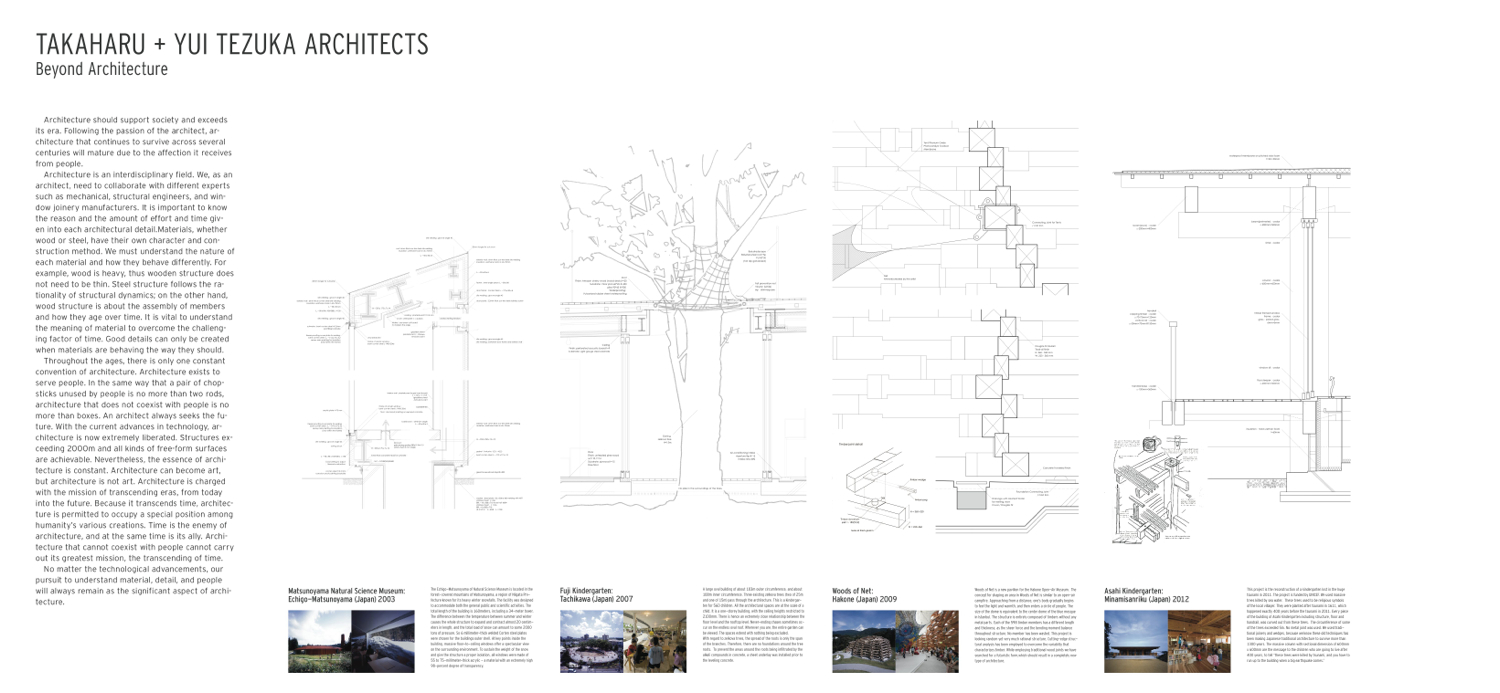Contemporary architects
Takaharu + Yui Tezuka – Architects Beyond Architecture
Architecture should support society and exceeds its era. Following the passion of the architect, architecture that continues to survive across several centuries will mature due to the affection it receives from people.
Architecture is an interdisciplinary field. We, as an architect, need to collaborate with different experts such as mechanical, structural engineers, and window joinery manufacturers. It is important to know the reason and the amount of effort and time given into each architectural detail.
Materials, whether wood or steel, have their own character and construction method. We must understand the nature of each material and how they behave differently. For example, wood is heavy, thus wooden structure does not need to be thin. Steel structure follows the rationality of structural dynamics; on the other hand, wood structure is about the assembly of members and how
they age over time. It is vital to understand the meaning of material to overcome the challenging factor of time. Good details can only be created when materials are behaving the way they should.
Throughout the ages, there is only one constant convention of architecture. Architecture exists to serve people. In the same way that a pair of chopsticks unused by people is no more than two rods, architecture that does not coexist with people is no more than boxes.
An architect always seeks the future. With the current advances in technology, architecture is now extremely liberated. Structures exceeding 2000m and all kinds of free-form surfaces are achievable. Nevertheless, the essence of architecture is constant.
Architecture can become art, but architecture is not art. Architecture is charged with the mission of transcending eras, from today into the future. Because it transcends time, architecture is permitted to occupy a special position among humanity’s various creations. Time is the enemy of architecture, and at the same time is its ally. Architecture that cannot coexist with people cannot carry out its greatest mission, the transcending of time.
No matter the technological advancements, our pursuit to understand material, detail, and people will always remain as the significant aspect of architecture.
Read text
Matsunoyama Natural Science Museum
Echigo-Matsunoyama (Japan) 2003
!The Echigo-Matsunoyama of Natural Science Museum is located in the forest-covered mountains of Matsunoyama, a region of Niigata Prefecture known for its heavy winter snowfalls. The facility was designed to accommodate both the general public and scientific activities. The total length of the building is 160meters, including a 34-meter tower. The difference between the temperature between summer and winter causes the whole structure to expand and contract almost 20 centimeters in length, and the total load of snow can amount to some 2000 tons of pressure. So 6 millimeter-thick welded Corten steel plates were chosen for the buildings outer shell. At key points inside the building, massive floor-to-ceiling windows offer a spectacular view on the surrounding environment. To sustain the weight of the snow and give the structure a proper isolation, all windows were made of 55 to 75- millimeter-thick acrylic – a material with an extremely high 98-percent degree of transparency.
Fuji Kindergarten
Tachikawa (Japan) 2007
A large oval building of about 183m outer circumference, and about 108m inner circumference. Three existing zelkova trees (two of 25m and one of 15m) pass through the architecture. This is a kindergarten for 560 children. All the architectural spaces are at the scale of a child. It is a one-storey building, with the ceiling heights restricted to 2100mm. There is hence an extremely close relationship between the floor level and the rooftop level. Never-ending chases sometimes occur on the endless oval roof. Wherever you are, the entire garden can be viewed. The spaces extend with nothing being excluded.
With regard to zelkova trees, the spread of the roots is only the span of the branches. Therefore,therearenofoundationsaroundthetreeroots. Topreventtheareasaround the roots being infiltrated by the alkali compounds in concrete, a sheet underlay was installed prior to the leveling concrete.
Woods of Net
Hakone (Japan) 2009
Woods of Net is a new pavilion for the Hakone Open-Air Museum. The concept for shaping an area in Woods of Net is similar to an open-air campfire. Approaching from a distance, one’s body gradually begins to feel the light and warmth, and then enters a circle of people. The size of the dome is equivalent to the center dome of the blue mosque in Istanbul. The structure is entirely composed of timbers without any metal parts. Each of the 598 timber members has a different length and thickness, as the sheer force and the bending moment balance throughout structure. No member has been wasted. This project is looking random yet very much rational structure. Cutting-edge structural analysis has been employed to overcome the variablity that characterizes timber. While employing traditional wood joints we have searched for a futuristic form,which should result in a completely new type of architecture.
Asahi Kindergarten
Minamisanriku (Japan) 2012
This project is the reconstruction of a kindergarten lost in the huge tsunami in 2011. The project is funded by UNICEF. We used massive trees killed by sea water. These trees used to be religious symbols of the local villager. They were planted after tsunami in 1611, which happened exactly 400 years before the tsunami in 2011. Every piece of the building of Asahi Kindergarten including structure, floor and handrail, was curved out from these trees. The circumference of some of the trees exceeded 5m. No metal joint was used. We used traditional joinery and wedges, because we know these old techniques has been making Japanese traditional architecture to survive more than 1300 years. The massive column with sectional dimension of 600mm x 600mm are the message to the children who are going to live after 400 years, to tell “these trees were killed by tsunami, and you have to run up to the building when a big earthquake comes.”
